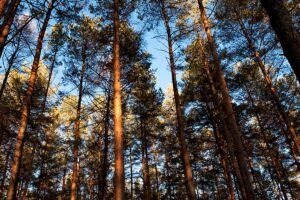Our bottom-up understanding of the timberland transactions and forest industry capital investments tracked in the Forisk Market Bulletin depends on the link between wood flows and cash flows. The (1) steady, localized harvesting and delivery of logs to (2) mills that manufacture the building and paper products demanded by consumers (3) generate the income that justifies, for private owners, replanting trees and managing their forests. In this way, the flows of wood and cash from timber are renewable.
This cycle of cash supports the steady dividends historically paid by timberland-owning real estate investment trusts (REITs) such as CatchMark Timber (CTT), PotlatchDeltic (PCH), Rayonier (RYN) and Weyerhaeuser (WY). As noted in previous posts on timber REITs, these dividends attract investors and provide information. At times, external forces interrupt the regular course of affairs and cause firms to adjust.
Timber REIT Dividend Decisions
In May 2020, in the midst of the COVID-19 market impact and recession, Weyerhaeuser (WY) suspended its dividend payments to shareholders to preserve cash. Then, on October 30th, 2020, Weyerhaeuser reinstated its dividend, employing a new “two-tier” structure. When non-standard decisions get made in the industry, our phone starts to ring. Several investors and clients called to ask, “can you please walk me through Weyerhaeuser’s new dividend structure?” and other key changes to their balance sheet.
Firms use cash flows to pay bills, meet obligations and help finance investments. For timber REITs, the obligations primarily comprise (1) debt service (interest payments on loans) and (2) dividend payments. Are these big obligations? In the case of Weyerhaeuser, dividends payments totaled ~$1 billion per year in 2018 and 2019.
Timber REITS do not make whimsical changes to dividend policies. In 2011, PotlatchDeltic (then Potlatch) implemented and executed a well-developed plan for temporarily reducing dividends that strengthened confidence in the business from shareholders during a period of stressed markets. Weyerhaeuser, in 2020 and facing tremendous uncertainty, took a prudent position to throttle back production, slow capital investment and suspend the dividend to preserve cash and manage debt.
Good Time to Restructure Debt
Weyerhaeuser has done a lot to restructure its balance sheet, effectively rolling debt forward and taking advantage of favorable interest rates, just as an individual might do with an existing mortgage. While much took place in 2019, 2020 examples include:
- March 2020: Weyerhaeuser issued $750 million of 4.00% notes due in April 2030. A portion of this was used to redeem $569 million 4.70% notes due in March 2021.
- October 2020: notified holders of 4.625% notes due in 2023 of plans to redeem the principal outstanding (~$500 million not including fees and penalties) in December.
New Dividend “Framework”
While parts of the U.S. economy struggled in 2020, these did not include home construction, residential real estate or solid wood products. Effective December 2020, Weyerhaeuser’s Board assessed the replenished coffers and declared a quarterly dividend of $0.17 per share (versus a prior dividend of $0.34 per share).
Weyerhaeuser also announced a new dividend framework “to enhance the company’s ability to return meaningful and appropriate amounts of cash to shareholders across a variety of market conditions.” This framework includes the (implied) $0.17 per share quarterly base ($0.64 per year) plus a potential and periodic variable supplemental cash payment that targets “total annual return to shareholders of 75 to 80 percent of annual Adjusted Funds Available for Distribution.” [Note: Weyerhaeuser defines Adjusted FAD as “net cash from operations adjusted for capital expenditures and significant non-recurring items.”]
The supplemental, while preserving flexibility for management, does incur additional variability for shareholders, as available funds could be used for dividends or “opportunistic share repurchases.” Also, Weyerhaeuser expects supplemental dividends to be announced annually, with the first payment made in Q1 2022.
How have investors responded to this announcement? The sentiments can be summarized as:
- We like receiving dividends.
- We understand the need for flexibility in tough times.
- We prefer dividends to buybacks.
- We hope this structure is temporary.
During its Q4 2020 call with analysts, Weyerhaeuser did indicate a plan to prioritize special dividends over buybacks. Also, sounding like reassurance to shareholders, the Company indicated that special dividends could be scheduled mid-year as soon as 2021, effectively laying out a path, supported by a strengthened balance sheet, for normalizing and standardizing dividend policy over the next two years.
This content may not be used or reproduced in any manner whatsoever, in part or in whole, without written permission of LANDTHINK. Use of this content without permission is a violation of federal copyright law. The articles, posts, comments, opinions and information provided by LANDTHINK are for informational and research purposes only and DOES NOT substitute or coincide with the advice of an attorney, accountant, real estate broker or any other licensed real estate professional. LANDTHINK strongly advises visitors and readers to seek their own professional guidance and advice related to buying, investing in or selling real estate.










With the cost of lumber for any type of construction it’s a wonder if there’s any market for lumber? Price’s are out the roof and just plain crazy! Anybody know WHY?